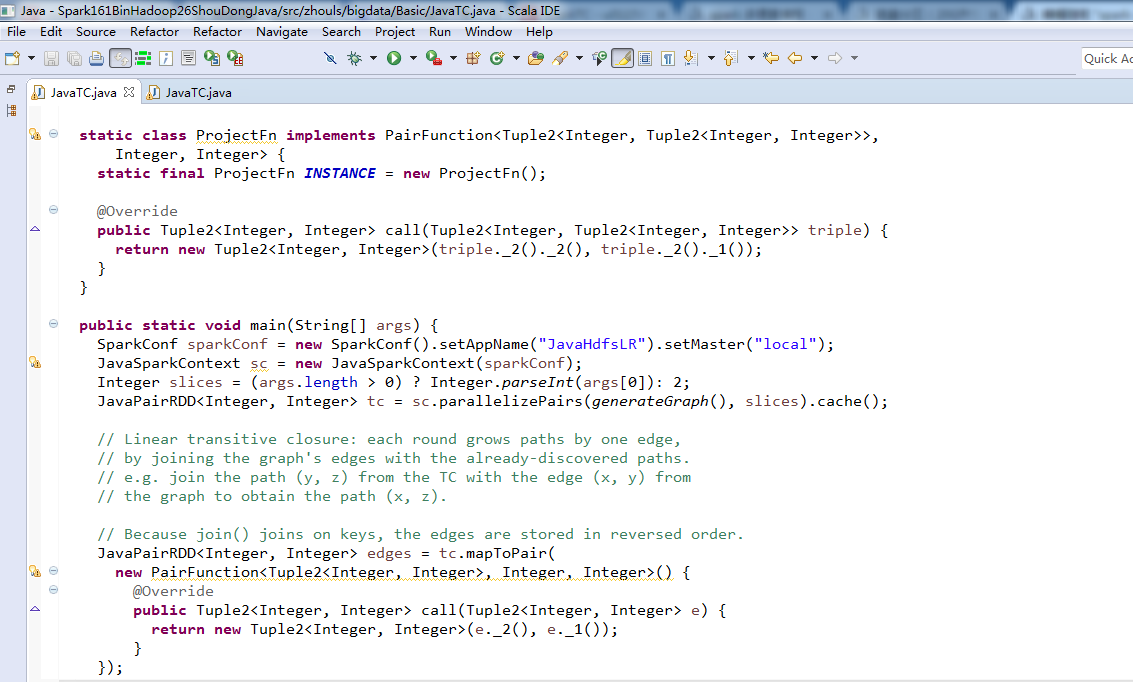spark-2.2.0-bin-hadoop2.6和spark-1.6.1-bin-hadoop2.6发行包自带案例全面详解(java、python、r和scala)之Basic包下的JavaTC.java(图文详解)
不多说,直接上干货!
spark-1.6.1-bin-hadoop2.6里Basic包下的JavaTC.java

/* * Licensed to the Apache Software Foundation (ASF) under one or more * contributor license agreements. See the NOTICE file distributed with * this work for additional information regarding copyright ownership. * The ASF licenses this file to You under the Apache License, Version 2.0 * (the "License"); you may not use this file except in compliance with * the License. You may obtain a copy of the License at * * http://www.apache.org/licenses/LICENSE-2.0 * * Unless required by applicable law or agreed to in writing, software * distributed under the License is distributed on an "AS IS" BASIS, * WITHOUT WARRANTIES OR CONDITIONS OF ANY KIND, either express or implied. * See the License for the specific language governing permissions and * limitations under the License. */ //package org.apache.spark.examples; package zhouls.bigdata.Basic; import java.util.ArrayList; import java.util.HashSet; import java.util.List; import java.util.Random; import java.util.Set; import scala.Tuple2; import org.apache.spark.SparkConf; import org.apache.spark.api.java.JavaPairRDD; import org.apache.spark.api.java.JavaSparkContext; import org.apache.spark.api.java.function.PairFunction; /** * Transitive closure on a graph, implemented in Java. * Usage: JavaTC [slices] */ public final class JavaTC { private static final int numEdges = 200; private static final int numVertices = 100; private static final Random rand = new Random(42); static List<Tuple2<Integer, Integer>> generateGraph() { Set<Tuple2<Integer, Integer>> edges = new HashSet<Tuple2<Integer, Integer>>(numEdges); while (edges.size() < numEdges) { int from = rand.nextInt(numVertices); int to = rand.nextInt(numVertices); Tuple2<Integer, Integer> e = new Tuple2<Integer, Integer>(from, to); if (from != to) { edges.add(e); } } return new ArrayList<Tuple2<Integer, Integer>>(edges); } static class ProjectFn implements PairFunction<Tuple2<Integer, Tuple2<Integer, Integer>>, Integer, Integer> { static final ProjectFn INSTANCE = new ProjectFn(); @Override public Tuple2<Integer, Integer> call(Tuple2<Integer, Tuple2<Integer, Integer>> triple) { return new Tuple2<Integer, Integer>(triple._2()._2(), triple._2()._1()); } } public static void main(String[] args) { SparkConf sparkConf = new SparkConf().setAppName("JavaHdfsLR").setMaster("local"); JavaSparkContext sc = new JavaSparkContext(sparkConf); Integer slices = (args.length > 0) ? Integer.parseInt(args[0]): 2; JavaPairRDD<Integer, Integer> tc = sc.parallelizePairs(generateGraph(), slices).cache(); // Linear transitive closure: each round grows paths by one edge, // by joining the graph's edges with the already-discovered paths. // e.g. join the path (y, z) from the TC with the edge (x, y) from // the graph to obtain the path (x, z). // Because join() joins on keys, the edges are stored in reversed order. JavaPairRDD<Integer, Integer> edges = tc.mapToPair( new PairFunction<Tuple2<Integer, Integer>, Integer, Integer>() { @Override public Tuple2<Integer, Integer> call(Tuple2<Integer, Integer> e) { return new Tuple2<Integer, Integer>(e._2(), e._1()); } }); long oldCount; long nextCount = tc.count(); do { oldCount = nextCount; // Perform the join, obtaining an RDD of (y, (z, x)) pairs, // then project the result to obtain the new (x, z) paths. tc = tc.union(tc.join(edges).mapToPair(ProjectFn.INSTANCE)).distinct().cache(); nextCount = tc.count(); } while (nextCount != oldCount); System.out.println("TC has " + tc.count() + " edges."); sc.stop(); } }
spark-2.2.0-bin-hadoop2.6里Basic包下的JavaTC.java

/* * Licensed to the Apache Software Foundation (ASF) under one or more * contributor license agreements. See the NOTICE file distributed with * this work for additional information regarding copyright ownership. * The ASF licenses this file to You under the Apache License, Version 2.0 * (the "License"); you may not use this file except in compliance with * the License. You may obtain a copy of the License at * * http://www.apache.org/licenses/LICENSE-2.0 * * Unless required by applicable law or agreed to in writing, software * distributed under the License is distributed on an "AS IS" BASIS, * WITHOUT WARRANTIES OR CONDITIONS OF ANY KIND, either express or implied. * See the License for the specific language governing permissions and * limitations under the License. */ //package org.apache.spark.examples; package zhouls.bigdata.Basic; import java.util.ArrayList; import java.util.HashSet; import java.util.List; import java.util.Random; import java.util.Set; import scala.Tuple2; import org.apache.spark.api.java.JavaPairRDD; import org.apache.spark.api.java.JavaSparkContext; import org.apache.spark.api.java.function.PairFunction; import org.apache.spark.sql.SparkSession; /** * Transitive closure on a graph, implemented in Java. * Usage: JavaTC [partitions] */ public final class JavaTC { private static final int numEdges = 200; private static final int numVertices = 100; private static final Random rand = new Random(42); static List<Tuple2<Integer, Integer>> generateGraph() { Set<Tuple2<Integer, Integer>> edges = new HashSet<>(numEdges); while (edges.size() < numEdges) { int from = rand.nextInt(numVertices); int to = rand.nextInt(numVertices); Tuple2<Integer, Integer> e = new Tuple2<>(from, to); if (from != to) { edges.add(e); } } return new ArrayList<>(edges); } static class ProjectFn implements PairFunction<Tuple2<Integer, Tuple2<Integer, Integer>>, Integer, Integer> { static final ProjectFn INSTANCE = new ProjectFn(); @Override public Tuple2<Integer, Integer> call(Tuple2<Integer, Tuple2<Integer, Integer>> triple) { return new Tuple2<>(triple._2()._2(), triple._2()._1()); } } public static void main(String[] args) { SparkSession spark = SparkSession .builder() .master("local") .appName("JavaTC") .getOrCreate(); JavaSparkContext jsc = new JavaSparkContext(spark.sparkContext()); Integer slices = (args.length > 0) ? Integer.parseInt(args[0]): 2; JavaPairRDD<Integer, Integer> tc = jsc.parallelizePairs(generateGraph(), slices).cache(); // Linear transitive closure: each round grows paths by one edge, // by joining the graph's edges with the already-discovered paths. // e.g. join the path (y, z) from the TC with the edge (x, y) from // the graph to obtain the path (x, z). // Because join() joins on keys, the edges are stored in reversed order. JavaPairRDD<Integer, Integer> edges = tc.mapToPair(e -> new Tuple2<>(e._2(), e._1())); long oldCount; long nextCount = tc.count(); do { oldCount = nextCount; // Perform the join, obtaining an RDD of (y, (z, x)) pairs, // then project the result to obtain the new (x, z) paths. tc = tc.union(tc.join(edges).mapToPair(ProjectFn.INSTANCE)).distinct().cache(); nextCount = tc.count(); } while (nextCount != oldCount); System.out.println("TC has " + tc.count() + " edges."); spark.stop(); } }
作者:大数据和人工智能躺过的坑
出处:http://www.cnblogs.com/zlslch/
本文版权归作者和博客园共有,欢迎转载,但未经作者同意必须保留此段声明,且在文章页面明显位置给出原文链接,否则保留追究法律责任的权利。
如果您认为这篇文章还不错或者有所收获,您可以通过右边的“打赏”功能 打赏我一杯咖啡【物质支持】,也可以点击右下角的【好文要顶】按钮【精神支持】,因为这两种支持都是我继续写作,分享的最大动力!




 浙公网安备 33010602011771号
浙公网安备 33010602011771号